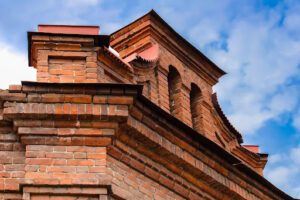While Italians refer to these roofs as “parapetto” and the Spanish know them as “parapeto,” parapets go far back as structures in the olden days like castles. Parapet roof designs also date back to temple designs and towers as a defensive inclusion. But ever since, parapets have experienced massive changes. They have also gotten incorporated into several modern houses.
Because of how several flat roofs are springing up, roofers have also seen the need to dig more into their knowledge about parapets. That’s why here, we’ll take you through their history, essence in the modern world, the different types, reasons anyone should have them, and a couple of other helpful information. Let’s go!
History of Parapets
While parapets, especially their designs, are strongly associated with medieval castle architecture, they also go far back to ancient Rome. Parapets, back then, were created from marble. From then, gothic architecture took in this old Roman feature, which paved the way for the classic castle architecture we think of today.
Another early standard parapet reference goes back to Moses in one of the holy books, the Torah. He said, “when you build a new house, make a parapet around your roof so that you may not bring the guilt of bloodshed on your house if someone falls from the roof.” This reality grounds how parapets have been an inclusion that had a significant impact far back as these times.
Apart from the safety measures parapets give to stop occupants from falling off a roof, these walls also have historical experiences securing inhabitants from foreign enemies. Because of the original nature of the parapets as low walls on the top of any structure, soldiers could hide behind them, giving themselves some safety during sieges and battles.
Several antique castles and military forts built defensive parapets. Commonly referred to as battlements, parapets were built on the roof to give cover to troops guarding the structure.
The Concept of Modern Roofing Parapets
As you might have already inferred, parapets were built on the sides of a roof to support the structure and accentuate the design. But parapets have also been seen as a safety inclusion and building and aesthetic quality.
As a safety inclusion, parapets are built to halt falls from the roof’s edge. For construction, on the other hand, parapets come in through flat roofs, having them in one way or another.
In light of these, people tend not to see parapets on modern houses because of their appearance on a flat roof line. These roofs also give any roofline an aesthetic and polished finish. Modern parapets are now being built to resemble a railing around the roofline, which expresses an excellent finish that’s deeply aesthetic.
But apart from the aesthetic value parapet roofs add to a building, they also stretch into several practical uses. So while houses today don’t have risks of having invaders trying to tear them down, parapet roofs have proven to be so much more than a safety feature.
But with all these influences parapets have on modern structures, do they have different types? How do they exist?
Types Of Parapets
We can group parapets according to two factors: operational shape and design style.
Design Style
In a lot of cases, the essence of various designs spills into the look of the whole building. So with a particular design comes a different look for its structure. In light of this factor, here are a few types of parapets:
- Embattled Parapets: While some might refer to these as the original style of parapets, embattled parapets perfectly describe what we explained as parapets in their history above.
Embattled parapets started as military guarding structures constructed in buildings, castles, towers, or even whole places like towns and countries. An example of this is embattled parapets crafted into the side of China’s “Great Wall.”
 While people might not build embattled parapet walls anymore, there is no denying the vintage and beautiful essence it gives to ancient buildings.
While people might not build embattled parapet walls anymore, there is no denying the vintage and beautiful essence it gives to ancient buildings.
- Perforated Parapets: Perforated parapets possess modern building construction designs and provide a heightened stylish worth to the roof line. Perforated parapets have walls that can be with or without gaps. Perforated, in this sense, translates to the walls having design elements directly constructed into their outer parts.
This quality allows the building owner to boost the structure’s curb fascination. Good instances of this are circles, arches, and several religious symbols.
- Plain Parapets: In the same way that embattled parapets had a reputation back in the day, people associate plain parapets with modern building construction. While many might associate boring with plain, you should know that that doesn’t stretch into its worth.
 Though the styles for plain parapets can get crafted from numerous materials, concrete is the general raw material for them. Plain parapets do not have gaps like embattled styles. This quality is why several designers choose them when rooftop privacy is the primary objective.
Though the styles for plain parapets can get crafted from numerous materials, concrete is the general raw material for them. Plain parapets do not have gaps like embattled styles. This quality is why several designers choose them when rooftop privacy is the primary objective.
- Paneled Parapets: Many often refer to paneled parapets as “double walls.” Because of how they have their base “plain” design with their outer parts having superficial inclusions, these parapets are pretty similar to their perforated counterparts.

A difference they share is that the paneled parapets are far more essential than perforated parapets, containing spare wall panels to give the wall more depth.
Operational Shape
Though the types of parapets we discussed above stem from the description of their design’s general nature, the shape significantly impacts a parapet’s purpose. Below are a few categorized according to shape:
- Flat Parapets: Flat parapets are reputable for being used by a lot of people. Most times, you can always find these shapes on flat roof surfaces. It is what comes to mind when people think about a wall sitting on a flat roof.
- Sloped Parapets: In the case of sloped parapets, you can come across them on sloped roofs’ edges like gable roofs. Sloped parapets go with the roof’s slope, which gives an architectural depth to the building.
- Stepped Parapets: You can find stepped parapets on both flat rooftops and pitched roofs. For flat roofs, the parapet’s base remains flat, but the wall is constructed, so there are steps to a peak at the top. This blueprint can make the building more striking, which is why places you’ll find them range from antique churches and government structures.
On pitched roofs, they bear a semblance to sloped parapets in that they go with the roof’s exact slope. The significant difference between the two types is that stepped parapets possess “steps” instead of a straight-line slope design.
- Curved Parapets: Curved parapets are much like stepped styles in that they feature curves instead of steps. They go with a pitched roof’s slope but possess a circular curving shape instead of a straight line.
Uses of Parapet Walls
Aesthetic Appeal
A consistent quality that keeps coming up about parapets is their aesthetic value. On a modern home’s roof, flat parapets can bring about a greater curb appeal for the house. When a rooftop parapet wall is well assembled, it can dramatically alter a building’s view and aura. A known reason people choose perforated and paneled styles over simple styles is to boost the building’s look.
Security
Another quality we highlighted earlier about parapets is their original use to bolster safety. A building with a flat roof will tend to have its owners or occupants to visit or converge on the rooftop. We all know it can be fun to have events on roofing areas. Apart from that, there are also great views at places like this compared to other spots in a building.
But with this entertainment comes its accompanying risks. Quite often, some people gathering on the rooftop move far too close to the roof’s edge and might fall off. All these dangers lessen with the help of a parapet.
Privacy
Many modern spaces have structures that don’t allow for much privacy between neighbors. While some people might be comfortable with this reality, others might consider it an invasion of privacy. This is where the tall roof wall parapet comes in.
With a parapet along your roof, your rooftop space can transition from an open space to a more secluded abode. Apart from the fact that these walls offer you privacy, they also conceal unpleasant objects like vents, service hatches, or HVAC units. This way, your space can have a better and clean aura.
Shelter From Natural Elements
Protection in living spaces these days has taken on a different meaning. It means shielding the roof space from rubbles and guarding them against harsh weather conditions. Here are a few ways parapets make this happen:
- By blocking things from the roof: Parapets, because of their wall nature, serve as a great way to block debris away from roofs and unfavorable weather off a flat roof.
- Debris: As a wall along your roof, a parapet can also keep away the dust, debris, and rubbish from your top, and wind or something else brings them there. This, in turn, makes it easy for home and building owners or occupants to maintain their spaces.
- Driving rains and water infiltration: Driving rains can also be relatively worse than debris. In cases like these, a well-constructed parapet can block water from entering the building. When water infiltrates roofs, it can lead to rotting, leaks, and depreciation of roof materials, to mention a few.
- By breaking up wind: Parapets can break up high winds, too, which can blow off certain roofing parts. High winds have a history of leading to vortices that can destroy roofs. Parapet walls come in to reduce happenings like these.
- Fire protection: Parapets are often used as firewalls by condo and apartment builders. They can prevent flames from moving up the outer part of the building and instantly setting off the roofing membrane. They are constructed extra thickly between one condo and the next.
Constructing A Parapet
From the materials to the shape and purpose, building a parapet should have a grounded intention. That’s why having some knowledge about building a parapet is essential Below are a few materials parapets are made from:
Wood
A lot of original parapets were crafted out of wood because of necessity. In today’s world, while wood is used as the primary material in modern parapet assembly, specific rules have made it grounded that its outside walls should be fireproof or framed with fire-retardant-treated wood. This development brings about the use of fire-retardant-treated wood, which is crucial for fire protection purposes.
Stone or Brick
Other natural material parapets can come from, including stone and brick. For walls crafted from metal or steel, one can use these stone or brick parapets as the wall’s coping cap. This happens because the stone is more malleable to slope towards the structure’s interior.
Steel and Metal
Modern materials like steel and metal are natural materials to think about when it comes to modern walls. The benefits of using these materials are that the metal can get shaped or crafted into any form the building comes in or needs. This way, the result comes out exactly as you plan it, in its thickness, height, image, or measurements. With steel, there’s an effective way of doing the job well with little manual labor.
Conclusion
In conclusion, here are some other essential pieces of information you should know about building a parapet:
- Parapet designs can be pretty complicated. Firstly, you’ll need wall cavities for the parapet framing to sink inside. Venting holes are also required for these cavities to work well.
- Parapet projects can also be costly because much time and care are spent building parapets.
- Because of the extensive nature of its design, there’s also a high chance that the project will take numerous days before your parapet roof gets finished
- It’s important to know that moisture causes immense damage to parapets, which can lead to leakages inside the home. That’s why parapet walls also need time-to-time checkups.
- Ensure that moisture drains away from your parapet roof, and don’t hesitate to work on any leaks you observe around any of the parapets. If you don’t, the leaks could become more extensive, and it could lead to the problem of an absolute roofing disaster
